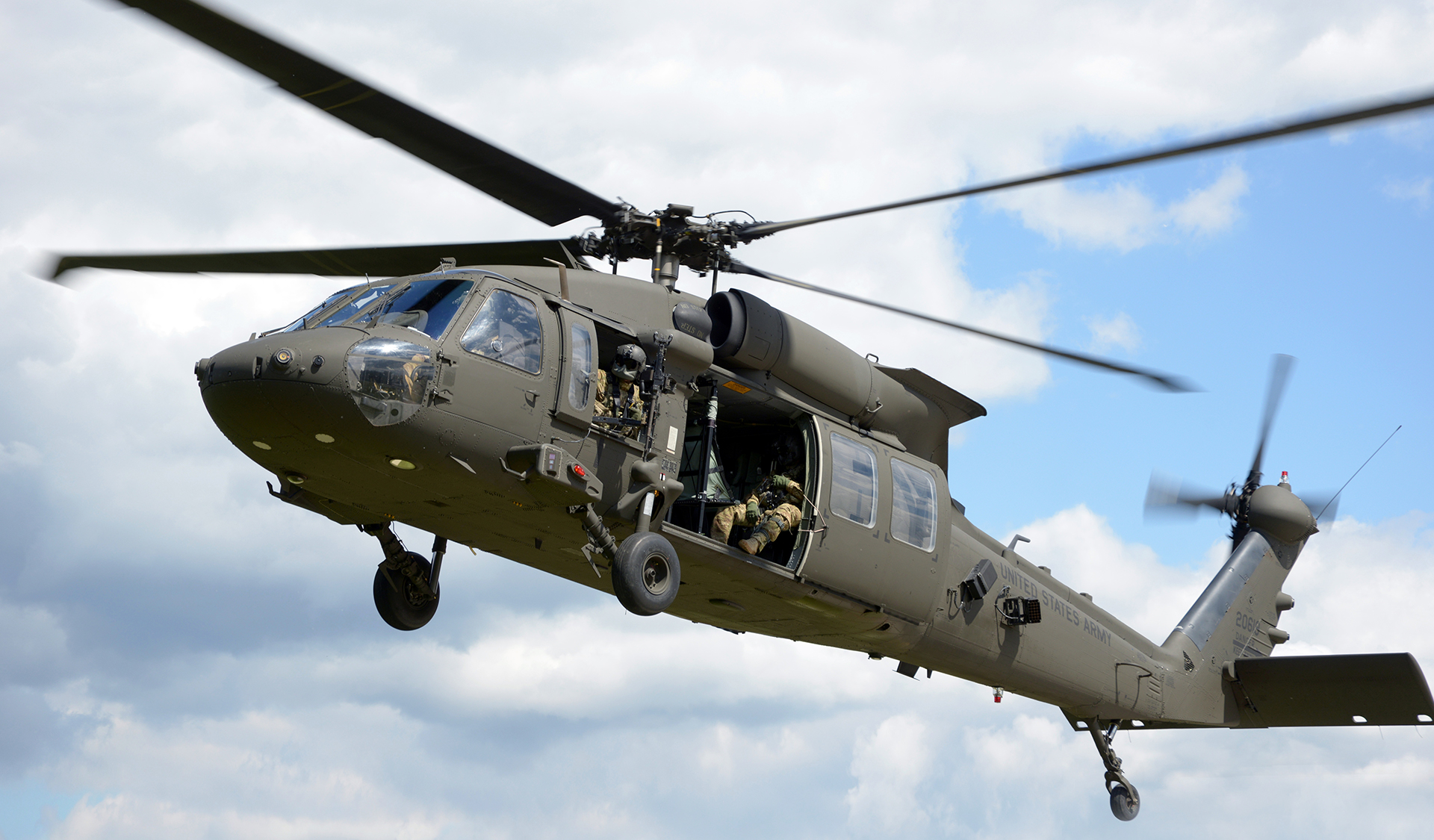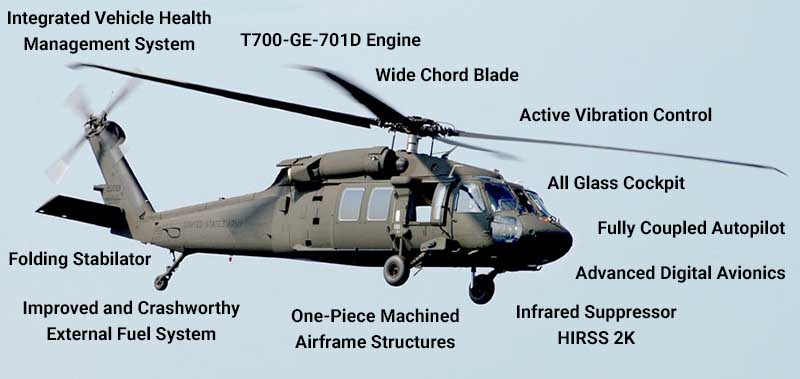Why the UH 60 Continues To Be a Favorite Choice Among Army Worldwide
Why the UH 60 Continues To Be a Favorite Choice Among Army Worldwide
Blog Article
UH-60: Technologies in Modern Helicopter Layout
The UH-60 helicopter stands as a criteria in contemporary air travel, showcasing significant advancements in layout and innovation that accommodate the developing demands of military operations. Its consolidation of innovative products not only enhances efficiency yet likewise addresses critical security issues. Moreover, the assimilation of innovative avionics has changed operational abilities, permitting higher situational understanding and decision-making performance. As we check out the advancement and crucial advancements of the UH-60, it becomes necessary to take into consideration exactly how these developments affect not only current applications yet additionally the future landscape of helicopter style.

Advancement of the UH-60
The advancement of the UH-60 Black Hawk helicopter stands for a significant milestone in aerospace design and army aeronautics. Presented in the late 1970s, the UH-60 was designed by Sikorsky Airplane to satisfy the USA Army's requirement for a functional energy helicopter efficient in performing a range of goals. Its layout highlighted speed, maneuverability, and durability, establishing brand-new standards for functional performance.
The UH-60 includes a distinctive four-blade blades system, which enhances lift and security, permitting it to run efficiently in varied atmospheres. Its airframe is constructed from sophisticated composite materials, adding to a reduction in weight while maintaining structural stability. The helicopter's style likewise incorporates better the rules of aerodynamics, which improves gas performance and raises range.
For many years, the Black Hawk has undertaken several upgrades to boost its abilities, including boosted engines, advanced flight control systems, and modular systems for easy maintenance and flexibility. The helicopter's ability to do objectives ranging from army transport to clinical evacuation has solidified its role as a foundation of U.S. armed forces operations. The UH-60 Black Hawk continues to be an archetype of exactly how advancement in helicopter layout can significantly affect military efficiency and functional flexibility.
Advanced Avionics Solutions
Innovations in avionics systems have changed the capacities of modern-day helicopters like the UH-60 Black Hawk, enhancing functional effectiveness and situational awareness (UH 60). The assimilation of sophisticated avionics permits for improved trip, communication, and navigation monitoring, making the UH-60 extra flexible in varied objective accounts
Among the vital features is the advanced digital cabin, which uses multifunction displays that supply real-time data, making sure pilots have prompt access to vital trip information. This streamlining of info minimizes pilot work and improves decision-making procedures during complicated operations. Additionally, the unification of GPS and inertial navigating systems makes it possible for specific positioning and route planning, boosting objective implementation in tough settings.
Furthermore, progressed avionics systems boost communication abilities through protected information links and voice communication systems, allowing smooth coordination with ground pressures and other aircraft. The assimilation of automated flight control systems better adds to improved security and control, particularly in damaging weather condition conditions or during low-altitude maneuvers.
Engine and Efficiency Enhancements
Engine performance in contemporary helicopters has actually taken a substantial jump forward, driven by technologies that improve integrity, effectiveness, and power. At the center of these improvements is the fostering of even more effective turboshaft engines, especially those using sophisticated materials and modern technologies that allow greater temperature tolerances and increased thrust capabilities. The UH-60 Black Hawk, for example, uses the T700-GE-701C engine, which includes a dual-channel, full-authority digital engine control system. This system improves efficiency while maximizing gas usage and reducing upkeep demands.
Additionally, the combination of engine health monitoring systems permits real-time diagnostics and predictive maintenance, substantially boosting operational integrity. These systems not just sharp teams to potential problems before they come to be essential yet likewise help with a lot more efficient maintenance organizing, thus lowering downtime.

Materials and Structural Innovations
Recent advancements in materials and structural layout have reinvented modern-day helicopter construction, enhancing both performance and longevity. The introduction of innovative composite products, such as carbon fiber reinforced polymers, has dramatically reduced weight while keeping architectural integrity. This change not only improves gas performance but also enhances payload ability, enabling helicopters like the UH-60 to execute even more varied objectives.
Additionally, technologies in light weight aluminum alloys and titanium components have actually contributed to enhanced resistance to corrosion and exhaustion, expanding the lifespan of critical airframe elements. The tactical use these materials has caused a reduction in maintenance demands and enhanced general functional readiness.

Furthermore, the integration of computer-aided layout (CAD) and additive manufacturing innovations has made it possible for extra lightweight structures and complex geometries, maximizing the wind resistant performance of helicopter designs. These innovations assist in rapid prototyping and manufacturing, permitting suppliers to respond promptly to progressing objective demands.
Security and Survivability Attributes
Safety and security and survivability features in modern-day helicopter design have actually come to be paramount, showing the enhancing demands for goal performance in challenging atmospheres. The UH-60 Black Hawk, a significant example, incorporates sophisticated technologies to boost staff and traveler defense. One of the most essential improvements is the unification of crashworthy gas systems made to reduce the threat of fire throughout effect. In addition, the airframe is constructed with reinforced materials that dissipate and soak up power, additional safeguarding occupants in case of a collision.
The helicopter also utilizes a ballistic protection system, that includes armored team seats and vital systems securing, lowering susceptability to small arms fire and shrapnel. Improved situational understanding is accomplished through advanced avionics and sensor modern technologies, allowing pilots to discover and prevent hazards properly.
In addition, the visit site combination of redundancy in vital systems-- such as twin engines and multiple trip control channels-- makes useful site sure continued operation even if one system stops working. The UH-60 is furnished with sophisticated emergency situation flotation gadgets, enhancing survivability in water landings. Collectively, these attributes not just boost the safety of personnel but additionally enhance goal success prices in aggressive environments, showing the dedication to quality in helicopter design.
Final Thought
The UH-60 helicopter represents a substantial development in contemporary air travel innovation, integrating innovative materials, innovative avionics, and robust safety features. Its evolution shows a dedication to boosting performance and functional efficiency while making sure pilot and staff survivability. The combination of lightweight composites and advanced navigation systems underscores the helicopter's flexibility in numerous military objectives. Overall, the UH-60 works as a benchmark for future advancements in helicopter style, symbolizing durability and adaptability in contemporary military operations.
The UH-60 helicopter stands as a criteria in modern-day air travel, showcasing substantial advancements in layout and technology that provide to the developing demands of armed forces procedures. As we explore the advancement and vital developments of the UH-60, it becomes necessary to take into consideration just how these advancements influence not just present applications yet additionally the future landscape of helicopter layout.
Presented in the late 1970s, the UH-60 was made by Sikorsky Airplane to meet the United States index Army's need for a versatile utility helicopter capable of performing a selection of objectives. The UH-60 Black Hawk stays a prime example of how innovation in helicopter layout can significantly affect army efficiency and operational versatility.
Overall, the UH-60 serves as a criteria for future developments in helicopter style, embodying strength and flexibility in modern army operations.
Report this page